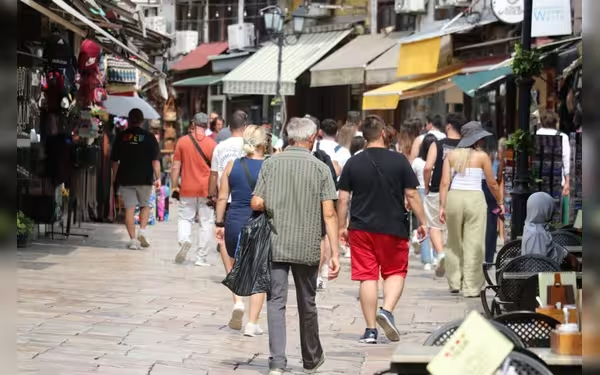Saturday, November 16, 2024 11:44 PM
Turkish Bazaar: A Living Ottoman Heritage in Skopje
- Turkish Bazaar showcases rich Ottoman heritage.
- Visitors experience traditional crafts and cuisine.
- Skopje's Stone Bridge symbolizes enduring legacy.
 Image Credits: thefrontierpost
Image Credits: thefrontierpostExplore the Turkish Bazaar in Skopje, a vibrant marketplace celebrating Ottoman heritage, crafts, and cuisine.
In the heart of North Macedonia’s capital, Skopje, lies a treasure trove of history known as the Turkish Bazaar. This vibrant marketplace is a living testament to the rich Ottoman heritage that once flourished in the region. With its narrow, cobblestone streets, the bazaar is adorned with stunning examples of Ottoman architecture, including mosques, inns, baths, and fountains. For many Turkish tourists, this historic area is the first stop when they visit Skopje, offering a glimpse into a past that still resonates today.
The Turkish Bazaar, often referred to as the “Old Skopje Bazaar,” is not just a place to shop; it is a cultural experience. Visitors can explore shops that showcase traditional crafts such as jewelry making and carpet weaving, which draw significant interest from tourists eager to take home a piece of this heritage. The bazaar also offers a delightful taste of traditional cuisine, making it a favorite spot for those who wish to indulge in local flavors.
Many Turkish tourists express a sense of belonging when they visit Skopje. Hasan Arslan, a tourist from Türkiye, shared his excitement about the city, stating, “Skopje excited us. It’s truly a beautiful and historic city, and seeing the traces of the Ottoman Empire made us especially happy.” His sentiments reflect a common feeling among visitors who find comfort in the familiar sights and sounds of their ancestors’ past.
Pınar Demirtaş, another tourist, described her emotional connection to Skopje, saying, “I felt like I was at home, even though I was far from my homeland. It was very emotional for me, and it’s been well-preserved.” Such experiences highlight the deep ties that many Turkish visitors feel to this historic city, where the echoes of their heritage can be felt in every corner.
Metin Duyar, another visitor, echoed these sentiments, noting how the atmosphere of Skopje reminded him of Türkiye. “The people are very helpful and share everything. We felt like we were walking around in our neighborhood,” he remarked. This sense of community and warmth is a hallmark of the Turkish Bazaar, making it a welcoming place for all who enter.
The Turkish Bazaar gained prominence in the 16th and 17th centuries, becoming a hub of activity and trade. Its cobblestone streets lead to significant Ottoman landmarks, including the Sultan Murad Mosque, Kurshumli An Inn, and the Davut Pasha Bathhouse. These sites not only serve as historical markers but also as reminders of the rich cultural tapestry that defines Skopje.
Food lovers will find plenty to enjoy in the local restaurants within the bazaar. Traditional North Macedonian dishes are served, with meatballs accompanied by baked beans topping the “must-try” list. This culinary experience adds another layer to the visit, allowing tourists to savor the flavors of the region.
One of Skopje’s most iconic landmarks is the Stone Bridge, also known as the “Fatih Sultan Mehmet Bridge.” This impressive structure, with its 12 arches and 220-meter length, has withstood the test of time, surviving numerous wars and earthquakes. It serves as a vital connection between the two banks of the Vardar River, symbolizing the enduring legacy of the Ottoman Empire in Skopje.
The Turkish Bazaar in Skopje is more than just a marketplace; it is a vibrant celebration of history, culture, and community. For Turkish tourists and locals alike, it offers a unique opportunity to connect with the past while enjoying the present. Whether you are exploring the narrow streets, tasting traditional dishes, or simply soaking in the atmosphere, the Turkish Bazaar is a place where the spirit of the Ottoman heritage truly lives on.













